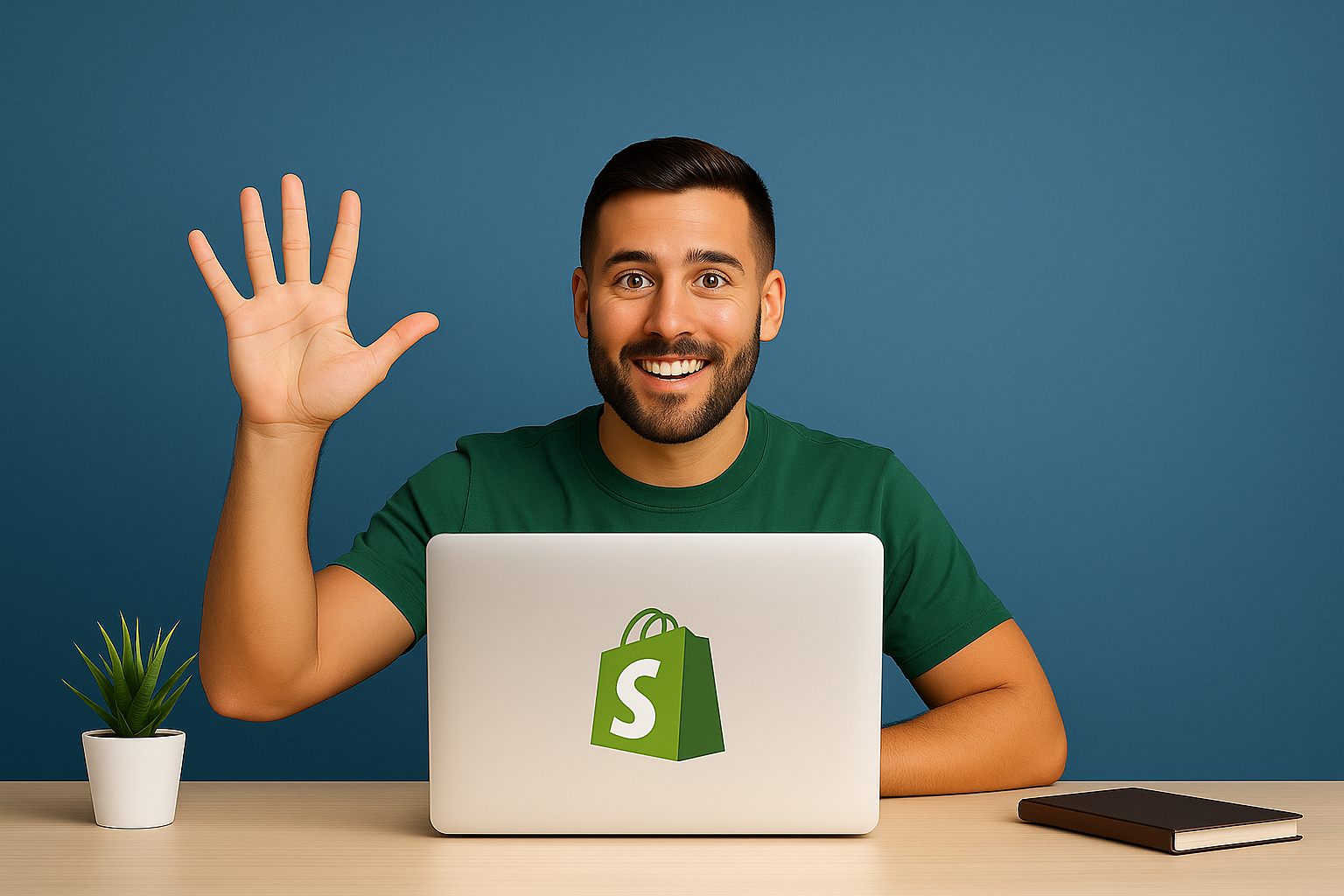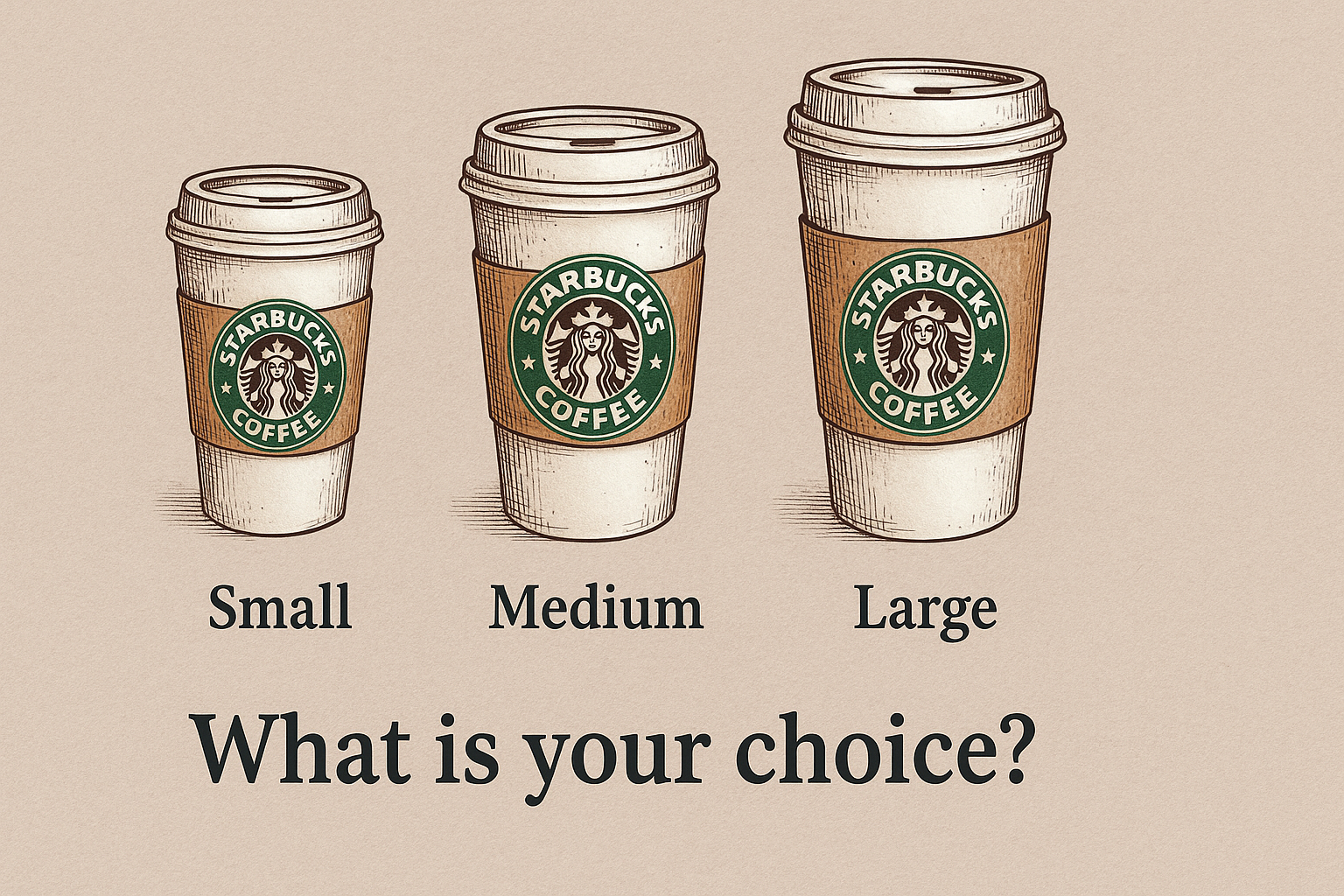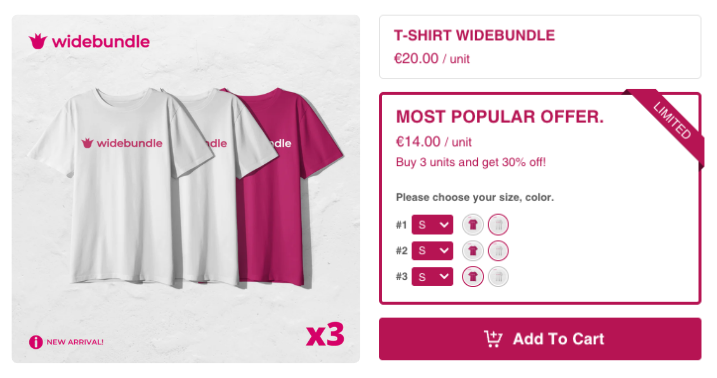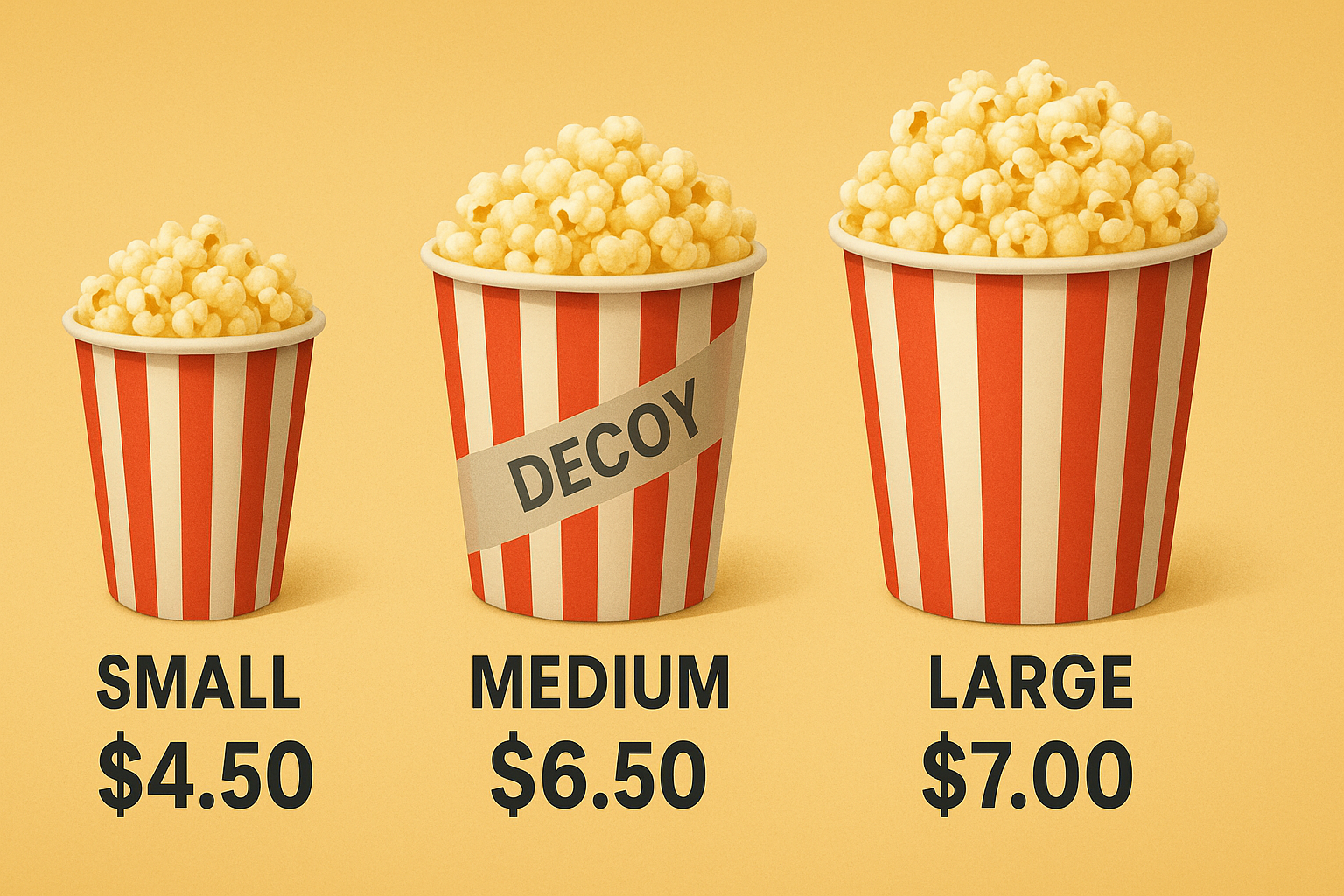5 Marketing Strategies to Increase Your AOV with Product Bundles

If you’re looking to increase your average order value (AOV) and make more revenue with your e-commerce store, using product bundles is one of the smartest moves you can make. Not only can it boost your profit margins, but it can also increase customer loyalty and reduce your cost per sale.
In this article, we’ll break down 5 powerful marketing strategies that you can use to maximize the impact of your bundles. From the Starbucks Effect to the Decoy Effect, these techniques have been proven to increase AOV and drive more revenue for online brands.
Whether you’re a seasoned e-commerce entrepreneur or just starting to scale your business, these strategies will help you convert more customers and increase your profit per sale.
Ready to take your store to the next level? Let’s dive in. 🚀
Strategy #1 – The Starbucks Effect

How It Works
The Starbucks Effect is a simple yet highly effective pricing strategy that uses the power of choice architecture to nudge customers toward a higher-priced option. It’s based on the idea that when presented with three pricing options, most customers tend to choose the middle one.
Here’s why it works: When people are given three options, their brains naturally avoid extremes. The cheapest option can seem too basic, while the most expensive option feels like an unnecessary luxury. This makes the middle option feel like the “smart” or “safe” choice, even if it’s still more expensive than the cheapest option.
Why It Increases AOV and Conversion Rate
The Starbucks Effect is powerful because it forces the brain to make a choice. When presented with three options, the customer feels compelled to pick one, rather than abandoning the purchase altogether. This is because the act of choosing creates a subtle sense of commitment, making it psychologically harder to walk away without making a decision.
Additionally, by including a middle option that feels like the “smart” choice, you reduce the risk of choice paralysis, where customers get overwhelmed and leave without buying. Instead, they are gently nudged toward the middle option, which often has a higher profit margin. This results in higher conversion rates and a more predictable average order value.
Examples and Best Practices
Here’s how to implement the Starbucks Effect effectively:
📝 Example 1:
- Basic Set: Coffee Beans (250g) - $15
- Standard Set: Coffee Beans (500g) + Coffee Scoop - $30
- Premium Set: Coffee Beans (1kg) + Coffee Scoop + Coffee Storage Canister - $45
Here, the Standard Set is likely to be the most popular because it feels like the best value, even if it’s more expensive than the Basic Set.
📝 Example 2:
- Basic Plan: Access to 10 courses - $50/month
- Standard Plan: Access to 30 courses + exclusive webinars - $100/month
- Premium Plan: Access to all courses + webinars + 1-on-1 mentorship - $150/month
Again, the Standard Plan is strategically priced to feel like the “smart choice”, encouraging more customers to choose this middle tier.
💡 Best Practices:
- Clearly highlight the “best value” option to make it stand out. This helps guide customers toward the middle tier.
- Use pricing that creates a clear value gap between each tier, making the middle option feel like a logical choice.
- Test different price points to find the sweet spot where customers consistently choose the middle tier.
- Use visual cues like badges (“Most Popular” or “Best Value”) to reinforce the choice.
Strategy #2 – The Scarcity Effect
How It Works
The Scarcity Effect is a powerful psychological trigger that leverages our natural fear of missing out. When a product or offer feels limited in quantity, it creates a sense of urgency that pushes customers to act quickly before it’s too late. This effect is rooted in the idea that scarce items are perceived as more valuable and desirable, simply because they are harder to get.
Why It Triggers Urgent Purchases
Scarcity works because it taps into a deep-seated survival instinct that tells us to grab what’s available before someone else does. When customers believe that a product might sell out soon, they’re less likely to hesitate and more likely to complete their purchase right away.
Additionally, scarcity can reduce the mental friction of making a decision. Instead of overthinking the purchase, customers feel a sense of urgency that drives them to take immediate action, boosting conversion rates and increasing AOV.
Examples and Best Practices
📝 Example 1:
- Limited Edition Bundles: Sell special limited-time or limited-quantity bundles, like “Winter Collection - Only 100 Sets Available”. This creates a sense of exclusivity that encourages quick purchases.
📝 Example 2:
- Stock Countdown: Use a real-time stock counter to show how many units are left, like “Only 5 units left in stock”. This small addition can significantly boost urgency.
💡 Best Practices:
- Clearly communicate the limited nature of your offer with phrases like “While supplies last” or “Limited stock available”.
- Use visual elements like red text or countdown timers to reinforce the urgency.
- Combine scarcity with social proof (e.g., “100+ sold this week”) to make the offer feel even more compelling.
- Test different levels of scarcity to find the sweet spot that maximizes conversions without creating unnecessary frustration for your customers.
Strategy #3 – The Urgency Effect
How It Works
The Urgency Effect is closely related to the Scarcity Effect, but instead of focusing on limited quantities, it focuses on limited time. The idea is simple: if customers know that an offer is only available for a short period, they are much more likely to act quickly to avoid missing out.
This strategy is particularly powerful because it triggers the “fear of missing out” (FOMO) while also adding a sense of pressure that forces customers to make faster decisions. It effectively shortens the customer’s decision-making process, leading to quicker conversions and higher AOV.
Why It Creates Immediate Demand
Urgency works because it creates a sense of time pressure that forces customers to act quickly, reducing the chances of them abandoning their cart. This is often paired with a sense of exclusivity, making the customer feel like they’re part of a special, time-limited opportunity.
Additionally, urgency can break the habit of procrastination. Many customers delay purchases because they want to “think about it”, but a countdown timer or flash sale can push them to make a faster decision, boosting your conversion rates.
Examples and Best Practices
📝 Example 1:
- Flash Sales: Run short, 24-hour bundle promotions like “Today Only - Save 30% on All Bundles” to create a sense of urgency.
📝 Example 2:
- Countdown Timers: Use a countdown timer on your product pages or checkout page, like “Offer Ends in 2h 15m 30s”, to add a visual reminder of the limited time available.
💡 Best Practices:
- Use clear, time-based language like “Hurry, Ends Today!” or “Limited Time Offer”.
- Combine urgency with strong visuals like red banners or animated countdowns to increase impact.
- Consider using personalized urgency, like sending abandoned cart emails with a “last chance” message.
- Test different time frames to find the optimal duration that maximizes urgency without creating customer frustration.

Strategy #4 – The Anchoring Effect
How It Works
The Anchoring Effect is a psychological principle that influences how people perceive value. It works by establishing a reference point (or “anchor”) that customers use as a baseline when evaluating prices. Once this anchor is set, it shapes how they perceive the value of the other options.
For example, if you present a high initial price as the “regular” price, any discount or bundle that appears afterward will seem like a much better deal in comparison. This effect is subconscious and incredibly powerful, as it takes advantage of the way our brains compare prices.
Why It Boosts Perceived Value
Anchoring is effective because it manipulates the customer’s perception of savings. By setting a high initial anchor, you create the illusion that the current price is a steal, even if it’s still profitable for you as a seller.
For example, if you sell a 3-pack of skincare products and show the regular price as $90 but the bundle price as $60, customers will perceive the $60 as a great deal because it’s significantly lower than the initial anchor price.
This strategy also reduces hesitation, as customers feel like they’re making a smart financial choice, which can lead to higher conversion rates and increased AOV.
Examples and Best Practices
📝 Example 1:
- Quantity Breaks: Sell a single item for $30 and a 3-pack for $75 (instead of $90). This makes the 3-pack feel like a better deal, even though it’s a higher total purchase.
📝 Example 2:
- Luxury Anchoring: Display the most expensive bundle first, followed by more affordable options. For example, if you sell premium leather bags, show a $500 bag first, followed by a $300 option. This makes the second option seem more reasonable by comparison.
💡 Best Practices:
- Use strike-through pricing to highlight the anchor (e.g., “Was $90, Now $60”).
- Clearly communicate the savings to reinforce the perceived value.
- Test different anchor points to find the optimal level that maximizes both AOV and conversion rates.
- Use visual elements like badges (e.g., “Best Value” or “Limited Time Offer”) to make the anchor price stand out.

Strategy #5 – The Decoy Effect
How It Works
The Decoy Effect is a pricing strategy that uses a “decoy” option to influence the way customers evaluate value. It’s based on the idea that people often compare options rather than evaluating each one independently. By adding a strategically placed third option, you can nudge customers toward the product you want them to buy.
This strategy works by presenting a “decoy” that isn’t meant to be chosen but instead makes another option look more attractive. It’s a psychological trick that takes advantage of our tendency to compare similar items and choose the best value.
Why It’s So Effective
The Decoy Effect is so powerful because it simplifies the decision-making process. Instead of trying to weigh the pros and cons of two options, customers are drawn to the option that appears to offer the most value in comparison to the decoy. This often results in higher AOV and increased conversion rates.
For example, consider this classic pricing model:
- Option A: Online Access - $59
- Option B: Print Only - $125
- Option C: Print + Online Access - $125
In this case, Option B is the decoy. It’s priced the same as Option C but offers less value, making Option C feel like a much better deal. This nudge can significantly increase the number of customers choosing the higher-priced option.
Examples and Best Practices
📝 Example 1:
- Popcorn Pricing: Small Popcorn - $4.50, Medium Popcorn - $6.50, Large Popcorn - $7.00. Here, the medium option is the decoy that makes the large size look like a much better deal.
📝 Example 2:
- Software Pricing: Basic Plan - $29/month, Standard Plan - $49/month, Premium Plan - $49/month. The Standard Plan is the decoy, pushing customers to choose the Premium Plan because it offers more features for the same price.
💡 Best Practices:
- Use a decoy that is similar in price to your highest margin option but clearly inferior in value.
- Clearly highlight the “best value” option to make the comparison even more obvious.
- Test different price gaps to find the optimal decoy that drives the most sales.
- Use visual cues like “Most Popular” badges to further reinforce the choice.

So, Which Bundle Strategy Is Right for You?
Choosing the right bundling strategy for your e-commerce brand depends largely on the types of products you sell and the customer behavior you want to encourage.
Here’s a quick recap to help you decide:
| Strategy | Best For | Main Benefit |
|---|---|---|
| The Starbucks Effect | Products with different value tiers | Increases AOV by encouraging mid-tier purchases |
| The Scarcity Effect | Limited edition products, exclusive collections | Creates urgency, boosts impulse buying |
| The Urgency Effect | Flash sales, time-sensitive promotions | Drives quick decisions, reduces cart abandonment |
| The Anchoring Effect | High-margin products, premium collections | Increases perceived value, reduces hesitation |
| The Decoy Effect | Subscription plans, volume pricing | Nudges customers toward higher-priced options |
Remember, the most successful brands mix and match these strategies to maximize their results. For example, you might use the Starbucks Effect for your main product line, the Scarcity Effect for limited edition collections, and the Decoy Effect for your premium bundles.
Test different combinations and see which ones drive the highest revenue and conversion rates for your store.
Want an Easy Way to Bundle Products on Shopify?
Creating high-converting bundles shouldn’t be a technical struggle. That’s why we built WideBundle — the go-to app for e-commerce brands that want to scale smarter.
- 80,000+ stores already trust WideBundle
- Average +23.7% revenue increase in 2024
- Over 1,000 reviews with a 4.9/5 rating on the Shopify App Store
- 7-days-a-week support in English, French, Spanish, Italian, Arabic, Serbian, and Portuguese
- Regular user interviews to build the features you really want
👉 Special offer: Get -10% for life on all plans, plus a 14-day free trial to see WideBundle in action.


